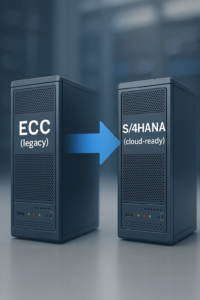Selective Data Transition Approach to SAP S/4HANA : As businesses evolve and grow, so do their software needs. For existing SAP customers, migrating to SAP S/4HANA represents a significant step towards modernizing their enterprise resource planning (ERP) solution. In our previous blog, we explored three distinct approaches to make this transition – System Conversion, New Implementation, and Selective Data Transition. In this article, we’ll dive deeper into the Selective Data Transition approach, focusing on how you can leverage it to move to SAP S/4HANA seamlessly.
What Is Selective Data Transition?
Selective Data Transition (SDT) is one of the three pathways available for migrating to SAP S/4HANA. Unlike the System Conversion approach, which transforms your existing system in its entirety, or the New Implementation approach, which builds a new system from scratch, SDT offers a more balanced approach. It allows you to selectively choose and migrate specific data and processes, providing a bridge between your old SAP ERP solution and the new SAP S/4HANA system.
Advantages of Selective Data Transition:
- Minimized Disruption: SDT minimizes business disruption as it enables you to retain critical business data and processes, avoiding a complete overhaul.
- Cost-Efficiency: By preserving existing data and configurations, you save on the costs associated with rebuilding your entire system from the ground up.
- Time-Saving: The SDT approach is typically faster than a New Implementation, as you are not recreating everything from scratch.
- Risk Mitigation: Since you’re retaining familiar processes and data, there’s less risk of process errors during the transition.
- Smooth Transition: Your organization can continue using SAP ERP while gradually transitioning to S/4HANA, ensuring a smoother and more gradual adoption process.
Disadvantages of Selective Data Transition:
- Complexity: SDT can be complex, particularly if you have customized extensively in your old SAP ERP system, making it harder to select and migrate data.
- Legacy Data: Retaining legacy data might lead to inefficiencies or data cleanliness issues that could have been resolved with a fresh start.
- Limited Innovation: If you are sticking closely to your old processes and data, you may miss out on the full range of innovations that SAP S/4HANA offers.
Here are the key steps and tools involved in the Selective Data Transition process:
- Assessment and Planning: The first step is to evaluate your current SAP ERP system. Identify which data sets are crucial for your business operations, compliance, and historical analysis. This assessment will help you determine what data to carry forward to SAP S/4HANA.
- Data Migration Landscape Transformation (DMLT) Tool: The DMLT tool is a vital component of Selective Data Transition. It helps you identify and extract the relevant data from your existing SAP ERP system and transform it to be compatible with SAP S/4HANA. This tool simplifies the process of data extraction, transformation, and loading.
- SAP S/4HANA Migration Cockpit: SAP provides the S/4HANA Migration Cockpit, which is an integrated solution for managing data migration. It assists in mapping and transferring data from the DMLT tool into SAP S/4HANA, ensuring data integrity and consistency.
- Data Cleanup and Mapping: Before migrating data, it’s essential to clean and standardize it. This step ensures that only high-quality, relevant data is transferred to SAP S/4HANA. Data mapping is also crucial, as it helps define how data from your old system will fit into the new structure.
- Testing and Validation: Rigorous testing is essential to ensure that the data transition process works seamlessly. Thoroughly validate the migrated data to identify any discrepancies or errors and make necessary adjustments.
- Go-Live and Post-Migration Activities: Once you are satisfied with the testing results, you can proceed with the SAP S/4HANA system go-live. After the transition, continue to monitor the system’s performance and address any post-migration issues promptly.
BSC Global as Your Service Provider
Choosing the right service provider can make a significant difference in the success of your SAP S/4HANA migration, especially when opting for the Selective Data Transition approach. BSC Global is a reputable and experienced service provider that can assist you at every stage of the migration process.
With their expertise, BSC Global can:
- Conduct a comprehensive assessment of your existing SAP ERP system.
- Implement the DMLT tool effectively for data extraction and transformation.
- Leverage the SAP S/4HANA Migration Cockpit for a seamless data transfer.
- Ensure data integrity through rigorous testing and validation.
- Provide ongoing support for post-migration activities and issue resolution.
Conclusion
Moving from SAP ERP to SAP S/4HANA using the Selective Data Transition approach offers organizations the flexibility to retain valuable data while optimizing their system for the future. When considering this migration, partnering with a trusted service provider like BSC Global is crucial for a successful transition.
By following the steps outlined in this blog and harnessing the power of tools like the DMLT tool and SAP S/4HANA Migration Cockpit, you can streamline the migration process and ensure minimal disruption to your business operations. With the right approach and support, your organization can unlock the full potential of SAP S/4HANA, driving innovation and efficiency in your business processes. Read More


 RECOGNISED WORLD OVER SOLUTIONS
RECOGNISED WORLD OVER SOLUTIONS
 Find out how BSC GLOBAL digitally transformed P2P cycle for worlds renowned brand in Automobile
Find out how BSC GLOBAL digitally transformed P2P cycle for worlds renowned brand in Automobile








